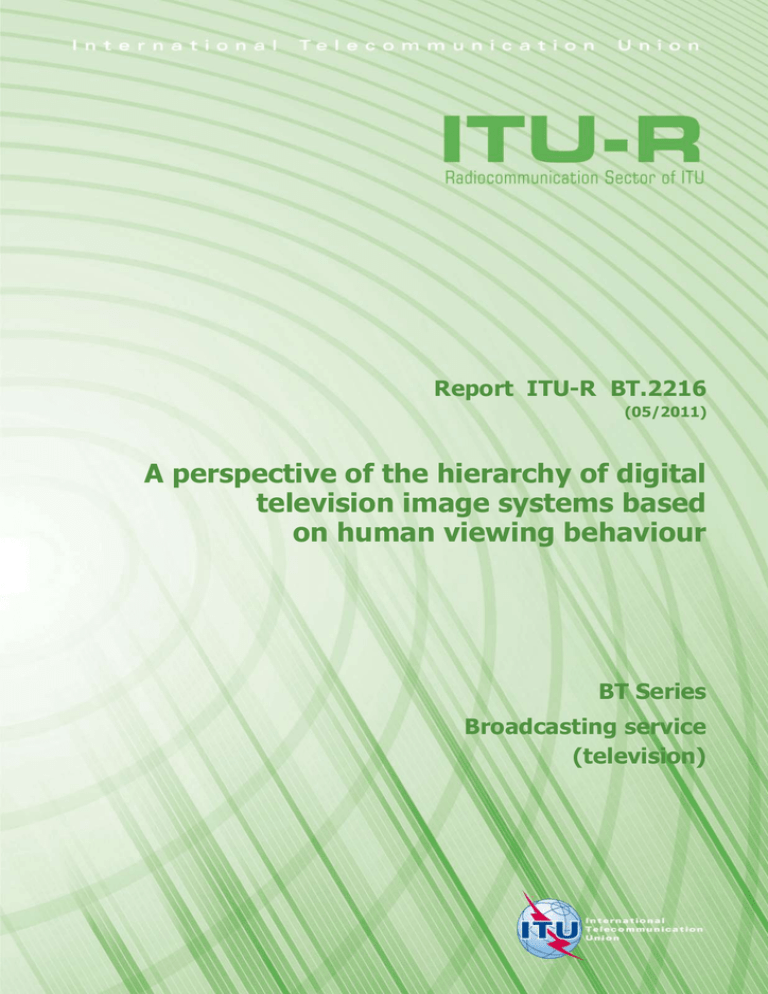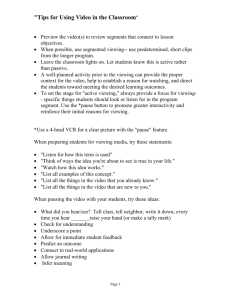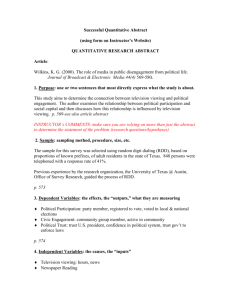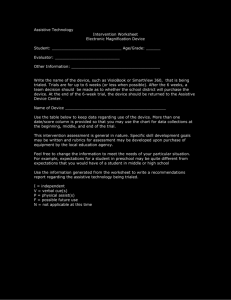
Report ITU-R BT.2216
(05/2011)
A perspective of the hierarchy of digital
television image systems based
on human viewing behaviour
BT Series
Broadcasting service
(television)
ii
Rep. ITU-R BT.2216
Foreword
The role of the Radiocommunication Sector is to ensure the rational, equitable, efficient and economical use of the
radio-frequency spectrum by all radiocommunication services, including satellite services, and carry out studies without
limit of frequency range on the basis of which Recommendations are adopted.
The regulatory and policy functions of the Radiocommunication Sector are performed by World and Regional
Radiocommunication Conferences and Radiocommunication Assemblies supported by Study Groups.
Policy on Intellectual Property Right (IPR)
ITU-R policy on IPR is described in the Common Patent Policy for ITU-T/ITU-R/ISO/IEC referenced in Annex 1 of
Resolution ITU-R 1. Forms to be used for the submission of patent statements and licensing declarations by patent
holders are available from http://www.itu.int/ITU-R/go/patents/en where the Guidelines for Implementation of the
Common Patent Policy for ITU-T/ITU-R/ISO/IEC and the ITU-R patent information database can also be found.
Series of ITU-R Reports
(Also available online at http://www.itu.int/publ/R-REP/en)
Series
BO
BR
BS
BT
F
M
P
RA
RS
S
SA
SF
SM
Title
Satellite delivery
Recording for production, archival and play-out; film for television
Broadcasting service (sound)
Broadcasting service (television)
Fixed service
Mobile, radiodetermination, amateur and related satellite services
Radiowave propagation
Radio astronomy
Remote sensing systems
Fixed-satellite service
Space applications and meteorology
Frequency sharing and coordination between fixed-satellite and fixed service systems
Spectrum management
Note: This ITU-R Report was approved in English by the Study Group under the procedure detailed
in Resolution ITU-R 1.
Electronic Publication
Geneva, 2011
ITU 2011
All rights reserved. No part of this publication may be reproduced, by any means whatsoever, without written permission of ITU.
Rep. ITU-R BT.2216
1
REPORT ITU-R BT.2216
A perspective of the hierarchy of digital television image systems
based on human viewing behaviour
(2011)
1
Introduction
Recommendations ITU-R BT.601, ITU-R BT.709, ITU-R BT.1201 and ITU-R BT.1769 define a
hierarchy of digital television image systems. Their pixel counts are recalled in Table 1; they stand
to each other as multiples of 2 based on the use of square pixels, except for SDTV systems.
TABLE 1
Hierarchy of digital television image systems based on spatial resolution
SDTV
HDTV
EHRI-1
EHRI-3
Spatial resolution
(number of
samples)
720 × 576
or
720 × 480-486
1 920 × 1 080
3 840 × 2 160
7 680 × 4 320
Optimal horizontal
viewing angle1
12°
32°
58°
96°
Aspect ratio
4:3
16:9
16:9
16:9
This text provides a perspective of those digital television image systems, based on four possible
viewing behaviours of humans, related to the human field of view2.
1
According to Recommendation ITU-R BT.1845, the “optimal horizontal viewing angle” is the horizontal
viewing angle under which an image is seen at its optimal viewing distance; the “optimal viewing
distance” of a digital image is the viewing distance at which two adjacent pixels of the source image
(before it is remapped on the display) subtend an angle of 1 arc-min at the viewer’s eye. Since this
definition is related to average measured values of human sight, which has a wide dispersion among
different persons, the angles are given as rough indications only and they should not be taken to exactly
and indifferently apply to all persons in all circumstances.
2 This perspective takes into account some well-known characteristics of human sight, namely:
– the image on the fovea covers an area of about 15° of the field of view;
– the field of view typically extends 60° upward, 75° downward, 95° outward and 60° inward (towards
the nose) with respect to the horizontal forward-looking direction;
– binocular vision typically spans 120° in the horizontal direction.
2
2
Rep. ITU-R BT.2216
The four viewing behaviours
A possible viewing behaviour (viewing behaviour A) is the one in which the television image at
its optimal viewing distance subtends a small enough angle for the viewer to be able to watch it
almost without moving his eyes. This happens when the television image on the retina is fully or
525-lines and 625-lines television systems (Recommendation ITU-R BT.601) is respectively 5 and
7 times the picture height. SDTV images thus subtend a nominal horizontal viewing angle of
respectively about 11° and 13° at the viewer’s eye (see Recommendation ITU-R BT.1845).
In this viewing behaviour, the edges of the television image fall well within the normal area of
highest visual acuity in the viewer’s field of view (the “fovea”). The viewing experience
corresponds to watching an action framed through a small window. Applications of SDTV support
this viewing behaviour.
Another possible viewing behaviour (viewing behaviour B) is the one in which the television
image at its optimal viewing distance subtends an angle large enough for the viewer to be able to
watch it by moving his eyes to follow the action, without moving his head. This happens when the
television image on the retina extends into near-peripheral vision, subtending for instance an angle
of the order of 30° at the viewer’s eye. Since HDTV images (Recommendation ITU-R BT.709) at
their optimal viewing distance subtend a horizontal viewing angle of 32° at the viewer’s eye,
applications of HDTV may be taken as examples of applications that support viewing behaviour B.
In this viewing behaviour, the edges of the television image fall within the viewer’s field of view
but they are partly outside his area of highest visual acuity. The viewing experience corresponds to
watching an action framed through a large window, whose edges may go unnoticed when the
viewer’s attention is focused on the centre of the image.
A further viewing behaviour (viewing behaviour C) is the one in which the television image at
its optimal viewing distance subtends an angle wide enough for the viewer to need to watch it by
moving his eyes and also slightly moving his head to follow the action. This begins to happen when
the television image on the retina extends beyond near-peripheral vision, e.g. when it subtends a 60°
horizontal angle. Since television images conforming to the 3 840 2 160 member of the LSDI
expanded hierarchy (Recommendation ITU-R BT.1769) subtend a nominal horizontal viewing
angle of about 58° at the viewer’s eye, applications of this LSDI hierarchy may be taken as
examples of applications that support viewing behaviour C.
In this viewing behaviour, the viewer can identify moving objects at the edge of the television
image but he cannot see them clearly. His induced reflex is to first move his eyes and then also
slightly move his head in order to bring the peripheral action into the fovea and see it clearly.
The viewing experience corresponds to watching an action framed through a very large window3.
Yet a further viewing behaviour (viewing behaviour D) is the one in which the television image
at its optimal viewing distance subtends an angle so wide that the viewer needs to watch it by
moving his eyes and also widely moving his head to follow the action. This happens when the
television image on the retina approaches far-peripheral vision, e.g. it subtends an angle of the order
of 120° which is the typical maximum viewing angle for binocular vision.
Since television images conforming to the 7 680 4 320 member of the LSDI expanded hierarchy
(Recommendation ITU-R BT.1769) subtend a nominal horizontal angle of about 96° at the viewer’s
eye, applications of this hierarchy member may be taken as examples of applications that support
a viewing behaviour close to viewing behaviour D.
3 A description of the human head-eye movement coordination mechanism can be found, for instance in
H.H.L.M. Goossens and A.J. Van Opstal “Human eye-head coordination in two dimensions under
different sensorimotor conditions” - Exp Brain Res (1997) 114:542-560.
Rep. ITU-R BT.2216
3
In this viewing behaviour, the viewer can detect movement at the edge of his field of view, but he
cannot clearly identify the moving objects because his visual acuity is inadequate at the edges of
this field of view. Consequently, the viewer’s induced reflex is to move first his eyes and then his
head to a sufficient extent to bring the moving objects into the fovea and see them clearly.
The viewing experience corresponds to watching an action from a balcony banister, where the walls
on both sides of the balcony normally go unnoticed. Similarly, the edges of the television image go
unnoticed except when the action happens at the edge of it.
3
Peripheral vision as an expression tool for programme directors
Human peripheral vision has comparatively low resolution but it is highly sensitive to movement.
The typical reaction to the perception of movement in peripheral vision is to promptly turn one’s
eyes and head in that direction, in order to bring the image of the moving objects into the fovea.
This may be due to a primeval survival mechanism and it is often coupled to increased alertness and
sometimes even anxiety.
Programme directors can use peripheral vision as a valuable tool in their toolkit, to convey moods
and emotions.
Take the tale of Little Red Riding Hood as an example.
If the director is working in SDTV, he may shoot a sequence showing Little Red Riding Hood
picking flowers in the wood. He may then cut to a sequence showing the Big Bad Wolf stealing in
behind the bushes. The viewer has no choice but to watch what the director shows him. Not a very
exciting experience.
If however the director is working in UHDTV, he may produce a sequence showing Little Red
Riding Hood picking flowers in the wood on the right side of the image. The viewer will turn his
eyes and head to watch Little Red Riding Hood. The director may then bring in the Big Bad Wolf
behind the bushes on the left side of the image. The viewer senses some movement in his left
peripheral vision, he will turn his eyes and head in that direction and, lo and behold!, he sees the
Big Bad Wolf stealing in behind the bushes. A somewhat more exciting viewing experience, which
makes the viewer feel emotionally involved in the action, almost as if he were part of it.
4
Tailoring UHDTV programmes for SDTV distribution
There are various ways to tailor a UHDTV programme for SDTV distribution, and each one poses
some problem. For instance:
–
the video of the programme could simply be down-sampled. This is technically very simple
to do, but it poses the problem that all the small details of the UHDTV image are lost, and
those details may contain information that would be important for the appreciation of the
programme;
–
the programme could be post-produced by passing the signal through an “intelligent”
device programmed to “follow the action”. For example, the device could be programmed
to follow the ball in a soccer match. Such devices exist and have been tested in operation.
They have the merit of dispensing from the presence of a programme director, but they
produce results which are generally below what the viewer would expect in a wellproduced programme of the same genre;
4
–
–
5
Rep. ITU-R BT.2216
the programme could be post-produced, panning over it to only show its most important
elements. This requires some post-production effort, and should be done under the
supervision of the programme creators, since the choice of the most important part of the
image is a matter of creative judgment. Furthermore, repeated panning movements may be
annoying for the viewer and may distract his attention away from the story that the director
is trying to tell;
the programme could be post-produced by identifying different parts of the original
UHDTV image and cutting among them in the same way that one would cut among
different cameras. This requires some post-production effort on the part of the programme
creators, but the result is more pleasant than the one obtained by panning over the original
image.
Conclusion
This Report has tried to provide a perspective of current and proposed digital television image
systems, including UHDTV, based on four different human viewing behaviours that relate to the
human field of view and the way humans look to the world around them.
It has highlighted some of the opportunities and challenges that UHDTV will offer to programme
directors in terms of extended creative options and new creative languages.
It has also identified some of the challenges in time and complexity attendant to the possible need to
tailor UHDTV programmes for distribution in SDTV and possibly also in HDTV.









